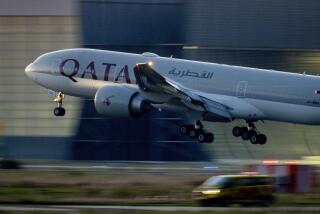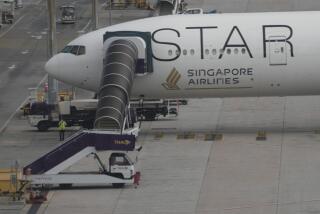A Rare, Perhaps Preventable, Death by Flight Turbulence
- Share via
Death from air turbulence is so infrequent that novelist Michael Crichton was able to weave a stunning yarn last year about an Asia-to-America jet that shook violently enough over the Pacific Ocean to kill four people.
But the rare hazard was real enough Sunday night, when a Tokyo-to-Honolulu flight encountered turbulence severe enough to fling passengers about the cabin, killing one woman and sending 83 others to the hospital, 12 with serious injuries. An inspection Monday found that the aircraft’s external skin had buckled in places.
According to Federal Aviation Administration statistics, turbulence is the leading cause of passenger injuries in nonfatal commercial aviation accidents, hurting about 60 people each year. The problem is serious enough that the FAA launched a multimedia campaign a year ago to alert airplane passengers to the importance of wearing seat belts.
From 1981 to November 1996, two people died, 63 people suffered serious injuries and 863 received minor injuries during 252 reported cases of severe turbulence. Sixty-one of the seriously injured passengers were not wearing seat belts and 59 were not buckled up when the seat belt sign was on.
Neither of the passengers killed in the turbulence incidents was wearing a seat belt, the FAA said. Many injuries are not to passengers but to flight attendants, who often must move about when the seat-belt light is on.
What happened on United Airlines Flight 826 remained under investigation Monday, but aviation officials said the lesson is clear.
“There’s a very simple preventative action to take: Buckle up,” said FAA spokeswoman Alison Duquette.
More to Read
Inside the business of entertainment
The Wide Shot brings you news, analysis and insights on everything from streaming wars to production — and what it all means for the future.
You may occasionally receive promotional content from the Los Angeles Times.










